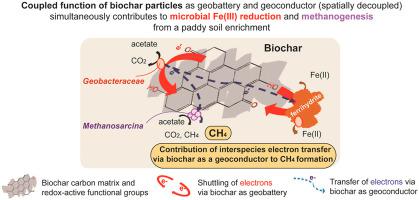Soil Biology and Biochemistry ( IF 9.7 ) Pub Date : 2021-10-02 , DOI: 10.1016/j.soilbio.2021.108446 Zhen Yang 1, 2 , Tianran Sun 3 , Sara Kleindienst 4 , Daniel Straub 4, 5 , Ruben Kretzschmar 6 , Largus T. Angenent 3 , Andreas Kappler 1, 7

|
Biochar can participate in biogeochemical electron transfer processes due to its electron-accepting and donating capabilities (i.e., geobattery) and electron conductivity (i.e., geoconductor). These two functions were separately demonstrated to play a role in biogeochemical iron cycling and methane formation. Yet, little is known about the coupled effect of both electron transfer mechanisms, even though naturally occurring electron transfer through biochar is expected to simultaneously rely on both geobattery and geoconductor mechanisms. Here, we incubated an anoxic paddy soil enrichment culture with acetate as the substrate to investigate how biochar's coupled electron transfer mechanisms influence the electron transfer pathways between microbes and Fe(III) minerals and how it impacts the soil microbial community composition. We found that biochar simultaneously stimulated microbial Fe(III) reduction and methanogenesis by 2.6 and 2.3 fold, but these processes were spatially decoupled. Small biochar particles (5–20 μm) caused higher Fe(III) reduction and methanogenesis rates than large particles (50–100 μm). The addition of biochar enriched a syntrophic acetate-oxidizing co-culture with dominating Fe(III)-reducing Geobacteraceae taxa and acetoclastic methanogenic Methanosarcina taxa. After acetoclastic methanogenesis stopped, the observed continuing methanogenesis was likely due to interspecies electron transfer caused by biochar functioning as a geoconductor transferring electrons from Geobacteraceae to Methanosarcina. In summary, the simultaneous occurrence of Fe(III) reduction and methanogenesis leads to the formation of a cell-biochar-mineral battery network and a cell-biochar-cell conductive network in an enrichment culture from a paddy soil.
中文翻译:

生物炭作为地电池和地导体的耦合功能导致在水稻土壤富集培养中刺激微生物 Fe(III) 还原和产甲烷
生物炭由于其接受电子和提供电子的能力(即地电池)和电子传导性(即地导体)可以参与生物地球化学电子转移过程。这两种功能分别被证明在生物地球化学铁循环和甲烷形成中发挥作用。然而,尽管预计通过生物炭自然发生的电子转移同时依赖于地电池和地导体机制,但对这两种电子转移机制的耦合效应知之甚少。在这里,我们以醋酸盐为底物培养了一种缺氧稻田土壤富集培养物,以研究 biochar 的耦合电子转移机制如何影响微生物和 Fe(III) 矿物质之间的电子转移途径,以及它如何影响土壤微生物群落组成。我们发现 biochar 同时刺激微生物 Fe(III) 还原和甲烷生成 2.6 和 2.3 倍,但这些过程在空间上是分离的。小生物炭颗粒(5-20 微米)比大颗粒(50-100 微米)导致更高的 Fe(III) 还原和产甲烷率。生物炭的添加丰富了以 Fe(III) 还原为主的同养醋酸盐共培养物Geobacteraceae类群和 acetoclastic 产甲烷Methanosarcina类群。在醋酸碎屑产甲烷停止后,观察到的持续产甲烷可能是由于生物炭作为地导体将电子从地杆菌科转移到甲烷八叠球菌引起的种间电子转移。总之,Fe(III)还原和甲烷生成的同时发生导致在稻田富集培养中形成细胞-生物炭-矿物电池网络和细胞-生物炭-电池导电网络。


























 京公网安备 11010802027423号
京公网安备 11010802027423号